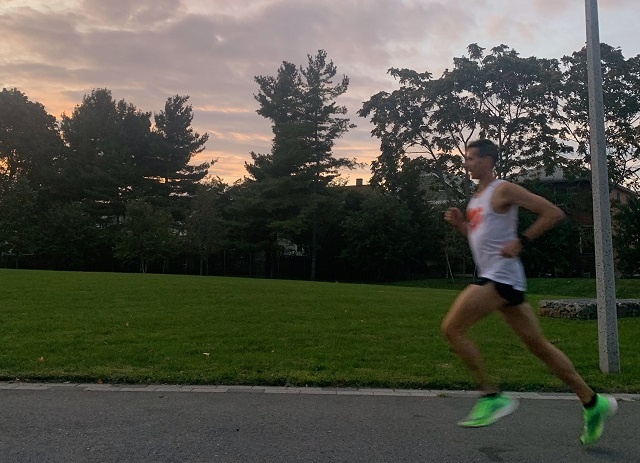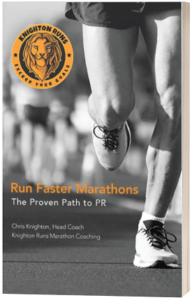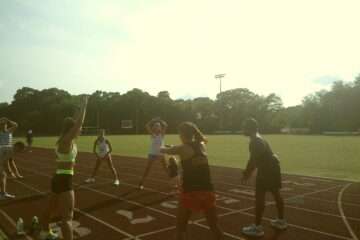Race-Specific Quality for Marathoners
Prepare best by practicing the specific demands of the marathon
Author: Coach Chris Knighton

Disclosure: This article may contain affiliate links. When you buy through links on our site, I may earn an affiliate commission. As an Amazon Associate I earn from qualifying purchases.
The Six Phases Of Marathon Training
- Base Building Phase
- Speed Development Phase
- Race-Specific Quality Phase <- We will focus on this here.
- Tapering for Peak Performance
- Race Day Performance
- Post-Race Recovery
Introduction
The third phase of marathon training focuses on the specific demands of the marathon.
Now that you’ve successfully completed your base phase, as well as your speed development phase, you will switch focus to getting comfortable with marathon pace and the 26.2-mile distance.
You will reach your highest mileage and then hold it consistently in this phase until tapering. Your longest long runs will be during this phase. Additionally, you will perform many of your long runs at or near marathon pace.
An example race-specific workout during this phase is 3 x 2 miles @ 10-seconds per mile faster than marathon pace with 1/2 mile easy run recovery.
An example long run during this phase is 20-miles with the final 10 @ marathon pace.
The race-specific quality phase is 8-12 weeks long.
You’ll discover how and why to include marathon-specific training in this article.
What is Race-Specific Running?
Race-specific running best prepares you for the specific demands of your race. To be successful at the marathon, you must develop not only a strong aerobic engine but build an incredibly resilient skeletal-muscular system that can carry you such a long distance as 26.2 miles at your fitness level.
Marathon-specific training also includes significant amounts of miles done in environments similar to that you will experience on race day (flat vs hilly routes, trying to match the weather, etc).
The race-specific phase combines long runs with workouts run at or near your goal marathon pace to condition your body to run your goal pace for 26.2 miles.
Why Focus on Race-Specific Training?
Most marathoners simply do not have enough strength and resiliency in their bodies to go the full length of the marathon at the top speed their aerobic engine will allow.
Shorter events like 5K to Half Marathon rely heavily on your aerobic engine and natural talent, but in the marathon it is impossible to succeed without putting in race-specific work.
The marathon is a battle of attrition for most athletes. Your limiting factor is not how fast your legs can move or how fast you can process oxygen like in the shorter events. In the marathon, your limiting factor is most likely your resilience to sheer muscular fatigue and breakdown.
I speak from experience, having run multiple marathons at what I thought was a comfortable effort, only to find my legs absolutely shattered at mile 20. This forced me to not just gradually slow down as I would in a shorter race, but instead forced me to walk. Having to walk in any race is a catastrophic failure when looking at what your true potential could have been on that day.
In the marathon race-specific phase of training, you focus on building your physical resiliency so you can go the distance at your desired speed.
What Does Race-Specific Training Look Like?
Perform two race-specific workouts each week for a period of eight to twelve weeks.
The first weekly workout should be faster than goal marathon pace. It serves to make goal pace feel more comfortable.
Perform 3-6 miles per week of running slightly faster than your goal marathon pace.
If you run 30 miles per week, run 3.
If you run 40 miles per week, run 4.
If you run 50 miles per week, run 5.
If you run 60+ miles per week, run 6.
These miles can be covered in intervals or steady tempo runs.
Your speed for this “faster than marathon pace” running could be just 10 seconds per mile faster than goal marathon pace. If you want slightly faster, it could be half marathon pace to lactate threshold tempo pace. Adjust the pace and duration of recovery between intervals accordingly. The faster you go in your intervals, the slower your recovery jogs should be.
Remember to never turn training into a race.
When in doubt, less is more with speed work. Focus on quality over quantity.
The second weekly workout should be a mid-week tempo run, a strong long run close to marathon pace, or a long run with goal marathon pace built in.
Run this on terrain similar to what you will experience on your goal racecourse at least every other week.
Grow the distance of your long run and duration of faster running over the course of your training, so that before the taper you can comfortably cover at least 10 miles at goal marathon pace in a 16 to 20-mile long run.
Types of Marathon Race-Specific Workouts
Marathon race-specific quality workouts are best done on the types of terrain you expect to run on during your goal race. If you are training for a flat race, do your pace-based workouts on a flat course. If you are training for a hilly race, make sure you do at least half of your workouts on a hilly course.
The track may be used for the speed workouts during this phase, but you may find the road, a bike path, or trail more enjoyable for long intervals.
Marathon-Speed Series
Progress through a series such as the one below over your marathon race-specific phase.
Run at 10 seconds per mile faster than goal marathon pace or up to half marathon pace. These workouts are about building strength and confidence over long intervals faster than marathon pace.
You may find these workouts are not that challenging. That is okay. They are aerobic workouts meant to make you stronger physically for the marathon. You don’t need to run faster to get the desired effect. Stay controlled.
Recover with easy running or jogging slow enough to maintain consistency over the duration of the workout.
Week 1 – 6 x 1 mile w/ 0.25 mile easy
Week 2 – 4 x 1.5 mile w/ 0.5 mile easy
Week 3 – 3 x 2 mile w/ 0.5 mile easy
Week 4 – 2 x 3 mile w/ 1.0 mile easy
Week 5 – 10 x 1000M w/ 200M jog
Week 6 – 2 x 3 mile w/ 1.0 mile easy
Week 7 – 3 x 2 mile w/ 0.5 mile easy
Week 8 – 6 x 1 mile w/ 0.25 mile easy
Other variations such as 3, 2, 1 mile or 1, 2, 3 miles are also fun to do.
Marathon-Specific Long Runs
Being fast enough is just one piece of the marathon puzzle. To be successful in the marathon, you also need to be able to cover the distance at your goal pace. To prepare you body for this, you need to perform three types of runs over varying types of terrain.
Run on the type of terrain your race will be on (flat vs hilly) at least every other week in your long run.
Long Run Type 1 – Long Slow Distance
If you are new to the marathon, this will be your most important type of long run. It doesn’t matter your speed if you can’t cover the distance. In this long run your only goal is to simply cover the distance. This long run is mostly about improving your aerobic system and conditioning your skeletal-muscular system to handle the impacts of running for hours on end. Cover this run at a comfortable, easy pace.
Work up to being able to run for 2 to 2.5 hours comfortably on your long run each week. Runs over 2.5 hours are very hard on our bodies and take longer to recover from. Any run over 2.5 hours should be taken seriously and given the respect it deserves in terms of post-run recovery. Because of this, most marathoners should not run longer than 3 hours in their training, even if they are working towards a marathon goal in the 4 to 5-hour range.
Long Run Type 2 – Strong Steady Effort (Marathon Pace + 30 seconds per mile)
The second type of marathon long run you may want to incorporate into your training is the strong and steady long run at a pace close to but slightly slower than goal marathon pace.
By running about 30 seconds per mile slower than marathon pace, you get most of the physical benefits of running marathon pace but at a significantly easier effort. While in heavy training it may be hard to hold 10 miles at marathon pace, it can feel fairly easy to hold 15+ miles at 30 seconds per mile slower than marathon pace.
This pace is not easy jogging like the long slow distance run described above. It is more of a moderate pace, but certainly not hard. Think of it as the fastest end of your “easy pace” spectrum. You feel good and like you are working, but it’s sustainable. This strong, feel-good pace often gives the fabled “runner’s high”.
This type of long run may be more applicable to faster marathoners who find their goal marathon pace more of a challenge to hold in training.
Runners who have little difficulty reaching their marathon pace and instead need to work on physical endurance to cover 26.2 miles without breaking down may be better suited performing the following type of long run – the marathon pace run.
Long Run Type 3 – The Marathon Pace Long Run
The marathon pace long run is arguably the best training for an athlete preparing to run the marathon at target pace. It is certainly the most specific type of training you can do.
Perform a marathon pace long run or mid-week tempo at marathon pace at least every other week in training. Increase the duration you run at marathon pace from just a few miles at the start of training all the way up to 10 or more at a time before peaking and tapering down.
If you can run 10 to 16 miles at goal marathon pace in training, you will be able to go the full distance on race day.
Examples of this type of long run put to action:
Mid-week tempo – 2 miles easy, 6 miles at marathon pace, 2 miles cooldown
w/ Weekend Long Run – Long slow distance for 16 miles
Weekend Long Run – 3 miles easy, 10 miles at marathon pace, 3 miles cooldown
Weekend Long Run – 8 miles easy to steady, 10 miles at marathon pace, 2 miles cooldown
Weekend Long Run – 2 miles easy, 3 x (3 miles at marathon pace, 1 mile easy), 2 miles cooldown
Summary
After reading this article, you now know what race-specific training for marathoners looks like. You learned when to include marathon-specific work into your training and why it is important. You also have been given examples of marathon-specific speed workouts and long runs to try in your next marathon training cycle.
Now, give them a try! After two to three months of being race-focused, I’m confident you will feel stronger than ever and ready to take your goal pace over the 26.2 miles on race day.
Continue the conversation in the comments below
What are your favorite marathon race-specific workouts? How many weeks of focusing on race-specific training have you found it takes you to feel confident in your endurance? Let me know in the comments below.



